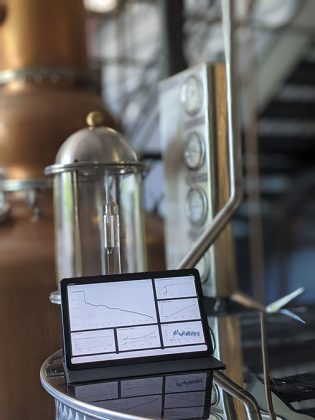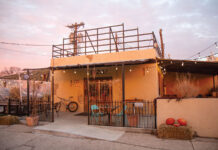Michael Griffo, a distiller with a doctorate in physics, likens alcohol to — of all things — pancakes. A self-characterized “experimenter,” he walks the line between the romance of making spirits and the science to master it. In other words, in this 44-year-old’s endeavors to produce gins, whiskeys and vodka, he maintains that his background in science facilitates the craftmanship.
“For me, ethanol is similar to pancakes, they are just a vehicle for flavor,” says Griffo, who along with his wife, Jenny, founded their eponymous distillery in 2013 in Petaluma, CA, about an hour north of the Golden Gate Bridge. “Pancakes deliver butter and ethanol delivers volatile congeners. The flavors that carry over during distillation depend on the temperature and ABV that you are distilling at, in addition to the concentration inside the kettle. Knowing where you are in the run and how hard you are running the still gives you more information to act on than just how it is tasting at the moment.”
Toward that, Griffo Distillery has developed its own system of controls and measures; most specifically, it had its 350-gallon steam still customized to its scientific specifications. It had ports cut into the copper structure to accommodate RTD pressure sensors and scales for measuring flows, which alert the producers as to where the run is at all times. This in turn allows the still to run “with super tight precision,” claims Michael Griffo. The temperature resolution he says is +/– 0.03 °C, which allows him to acquire the ABV of the vapor in the still with high accuracy (+/– 0.05% ABV).
“In my experience, the difference between a good gin and a great gin can be exactly that tight,” Griffo explains, referring to their process of collecting pressure, flow rates, total collected, chilling and reflux data on the still.
“We use the same mathematical framework that guides rockets and the same AI computer code that fuels modern robots,” Griffo says proudly, adding, “All of this isn’t to sell short creativity and a good palate, but I feel it’s critical to have good controls on your equipment to achieve good results.
“The science behind distillation is really interesting, but also the precision and the mathematics that we use every day is pretty complicated and is well suited to scientists.”
What makes the science so interesting to him?
“I think there are two parts to this,” he says. “The first is the science that we use day to day. The science behind the controls we use at the distillery is fun to build and optimize, requiring good data science skills.”
Griffo and his team also built robots — no, not the creepy kind with arms or legs — that work side-by-side with his crew to help mash, ferment and distill. “All of this is more than just engineering because we run actual experiments, review the results, learn and iterate.”
For example, distilling the same ingredients differently can completely change Griffo’s gin. “And the metrics we use to define how we distill enables us to create quality and consistency,” says the head distiller. “If the settings are off on the still, it can be an hour before you get the spirit back into spec, and if it’s a delicate unaged spirit, it can completely throw off the profile of the final product. Gin is also particularly difficult to maintain perfect balance on because you have so many variables, including the quantity of each botanical, the lot it came from, the harvest. You have to be very methodical and scientific to create a great and consistent spirit and for us, it’s a multivariable optimization problem that has at least 20 dimensions!”
Griffo’s still was manufactured by Vendome Copper & Brass Works of Louisville, KY. “With their help we were able to put in a few extras that improve our distilling tremendously,” Griffo explains. “With high levels of control and information, we’re able to make precise adjustments while distilling based on taste and all of the other high accuracy data coming from the still. We love how easy it is to consistently tune the level over louche on a gin or the depth of flavor on a vodka in addition to other spirits like pulling across clean fruit flavors on a brandy.
“With the way the still performs there’s no guesswork on what the still is doing or what will happen if we change the settings. This level of control improves the quality of the distillate and the consistency. It has also shortened the learning curve on our side, because we can so easily see what is going on with the still and how it affects the distillate.”
Nothing at the distillery is “off the shelf,” Michael Griffo insists. He explains that when he sat down at Vendome to go over the design on Griffo’s custom still, “We asked for a few additions that they said nobody has asked for before. We just wanted a few extra ports at specific locations on the back of the still so that we could run sensors into the vapor path. With those extra ports we were able to run telemetry with temp sensors and pressure sensors; we have flow meters on the distillate and the receiving tanks are on scales. All of this data gets sent off to a database to process before sending it back to the operator or for automated processes to make decisions and send off instructions to the steam and cooling modulation controls.”
With some number crunching, Griffo further explains, the sensor data and control states give him a great depth of control. The sensors inside the still are precise and accurate enough that they can do a little physics and calculate the ABV of the vapor inside the still.
“We relax these curves to empirical measurements to get super tight fits. All of this allows us to do things we couldn’t do otherwise,” he says. As a further example: At any moment his team knows the run efficiency, what the collection rate is, and an ETA on upcoming cuts. “We can see exactly how settings changes affect the ABV and collection rates, and we can control for summer and winter temperature-swings that effect reflux and dephlegmator cooling power.”
Griffo Distillery produces annually about 5,000 cases of gin, whiskey, vodka, single malt whiskies, brandies and a coffee liqueur. Its products are distributed in 14 states, the UK and the Philippines. The small city of Petaluma (pop. 58,000) is seemingly chockablock with about four distilleries and many breweries, not to mention it sits in the middle of Sonoma County wine country. The botanicals, grains and fruit that comprise Griffo’s mash are abundant throughout the agrarian region. Also, a half-block from Griffo stands the Lagunitas Brewery, which according to Griffo means, “there’s a lot of beautiful yeast and bacteria (nearby)” that enhance the aromatics and good residual organisms that accumulate in the distillery.
That’s the romantic side of Griffo’s operation. But it becomes apparent — considering Michael Griffo’s proclivities toward physics — that the scientific aspect is the distillery’s raison d’être.
Of the old-world craft side, he explains, the fact that he’s surrounded by winemakers in Sonoma County, his palate and the education that he’s derived from them, “has influenced my fermentation, distillation style, barrel aging techniques and production all the way to packaging spirits.”
But he believes there’s a wider trend toward “scientific distilling,” similar to what he’s doing at Griffo.
“I think there is a broader trend of scientific distilling,” he declares. “Since the uprising of craft in distilling, I’ve seen and heard of a large number of new distilleries that are founded by chemists, engineers and other hard scientists. I haven’t met any other physicist-distillers, but I wouldn’t be surprised to hear of others. I think there are a number of reasons for this. For one, the science behind distillation is really interesting, but also the precision and the mathematics that we use every day in the distillery are pretty complicated, and well suited to scientists.”
He certainly believes scientific distilling suits him.
“There are so many variables that go into a good spirit that if you don’t get a handle on them, then the final product will be either poor quality or inconsistent — or both,” he says. “I think that whether the distiller recognizes it or not, they are practicing a scientific approach in their distilling and the better the approach, the more quickly they will learn and improve quality and consistency. So, we built out our distillery to have the best accuracy and controls available, even down to fabricating our own systems and writing predictive algorithms that help us know when and where cuts will be made in the distillation. In the end, all of our spirits are still palate-driven which, to us, is the final measurement that tells us if our experiment was a success. But having a scientific approach with the proper tools to control and make good decisions is vital for a consistently good product.”
The second part of this, he explains, is the science behind what is created, the materials of food science and the limits of our understanding in this area of science: “While we eat and drink food every day, it’s a very complicated system of processes that create the food, how we perceive it and how our bodies process it.”
As an example, Griffo cites a scientific paper produced by UC Davis’ Food Science department that conducted a survey on the composition and the fingerprint of American whiskeys using UHPLC-QTOF MS (ultra-high performance liquid chromatography – quadrupole time-of-flight mass spectrometry) analysis.
“One of the results of the paper was that the distillery that produced the whiskey was more easily identified than the type of whiskey, which speaks to all the little choices we make in the distillery and how big of an impact they have on the final spirit,” he explains. “People talk about the depths of our oceans being as mysterious as space, but there is a world of unknowns in the food we consume every day!”
Griffo concedes there’s “a fine balance between romance and science behind the process.” He just believes that“It helps the art to have a good foundation in the science.”












